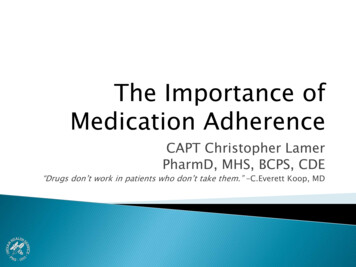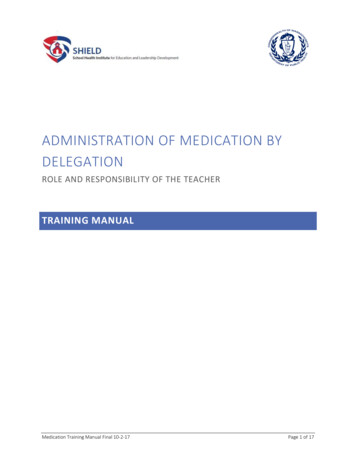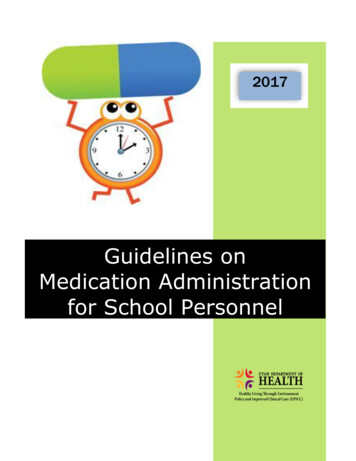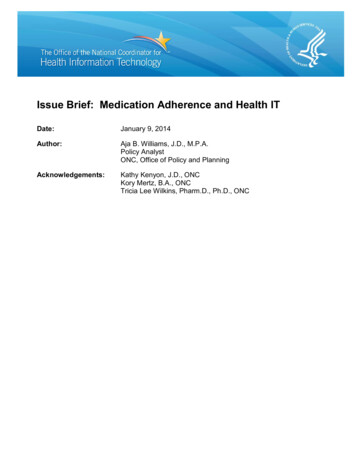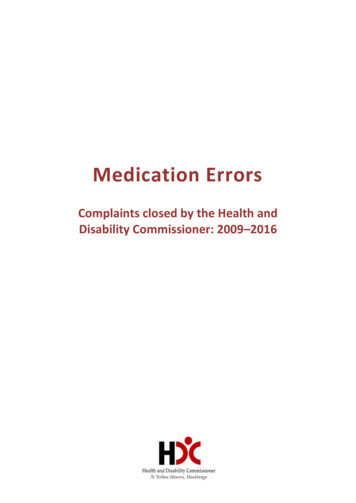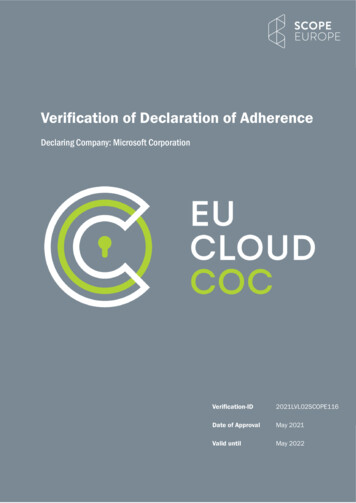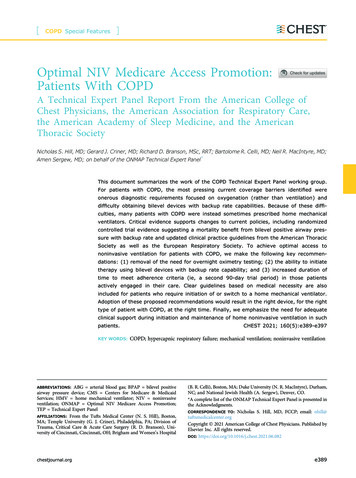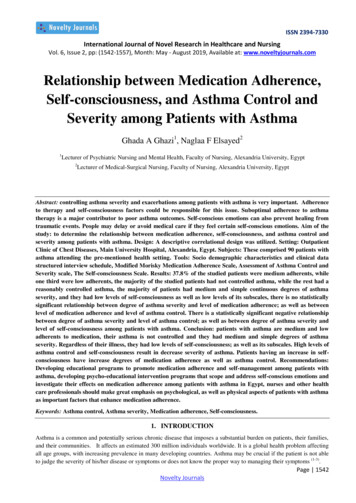
Transcription
ISSN 2394-7330International Journal of Novel Research in Healthcare and NursingVol. 6, Issue 2, pp: (1542-1557), Month: May - August 2019, Available at: www.noveltyjournals.comRelationship between Medication Adherence,Self-consciousness, and Asthma Control andSeverity among Patients with AsthmaGhada A Ghazi1, Naglaa F Elsayed21Lecturer of Psychiatric Nursing and Mental Health, Faculty of Nursing, Alexandria University, Egypt2Lecturer of Medical-Surgical Nursing, Faculty of Nursing, Alexandria University, EgyptAbstract: controlling asthma severity and exacerbations among patients with asthma is very important. Adherenceto therapy and self-consciousness factors could be responsible for this issue. Suboptimal adherence to asthmatherapy is a major contributor to poor asthma outcomes. Self-conscious emotions can also prevent healing fromtraumatic events. People may delay or avoid medical care if they feel certain self-conscious emotions. Aim of thestudy: to determine the relationship between medication adherence, self-consciousness, and asthma control andseverity among patients with asthma. Design: A descriptive correlational design was utilized. Setting: OutpatientClinic of Chest Diseases, Main University Hospital, Alexandria, Egypt. Subjects: These comprised 90 patients withasthma attending the pre-mentioned health setting. Tools: Socio demographic characteristics and clinical datastructured interview schedule, Modified Morisky Medication Adherence Scale, Assessment of Asthma Control andSeverity scale, The Self-consciousness Scale. Results: 37.8% of the studied patients were medium adherents, whileone third were low adherents, the majority of the studied patients had not controlled asthma, while the rest had areasonably controlled asthma, the majority of patients had medium and simple continuous degrees of asthmaseverity, and they had low levels of self-consciousness as well as low levels of its subscales, there is no statisticallysignificant relationship between degree of asthma severity and level of medication adherence; as well as betweenlevel of medication adherence and level of asthma control. There is a statistically significant negative relationshipbetween degree of asthma severity and level of asthma control; as well as between degree of asthma severity andlevel of self-consciousness among patients with asthma. Conclusion: patients with asthma are medium and lowadherents to medication, their asthma is not controlled and they had medium and simple degrees of asthmaseverity. Regardless of their illness, they had low levels of self-consciousness; as well as its subscales. High levels ofasthma control and self-consciousness result in decrease severity of asthma. Patients having an increase in selfconsciousness have increase degrees of medication adherence as well as asthma control. Recommendations:Developing educational programs to promote medication adherence and self-management among patients withasthma, developing psycho-educational intervention programs that scope and address self-conscious emotions andinvestigate their effects on medication adherence among patients with asthma in Egypt, nurses and other healthcare professionals should make great emphasis on psychological, as well as physical aspects of patients with asthmaas important factors that enhance medication adherence.Keywords: Asthma control, Asthma severity, Medication adherence, Self-consciousness.1. INTRODUCTIONAsthma is a common and potentially serious chronic disease that imposes a substantial burden on patients, their families,and their communities. It affects an estimated 300 million individuals worldwide. It is a global health problem affectingall age groups, with increasing prevalence in many developing countries. Asthma may be crucial if the patient is not ableto judge the severity of his/her disease or symptoms or does not know the proper way to managing their symptoms (1-3).Page 1542Novelty Journals
ISSN 2394-7330International Journal of Novel Research in Healthcare and NursingVol. 6, Issue 2, pp: (1542-1557), Month: May - August 2019, Available at: www.noveltyjournals.comManagement of asthma becomes suboptimal due to poor adherence to evidence-based guidelines. Non adherence totherapeutic regimens is a constant challenge to nurses and other health professionals. Understanding the benefits ofadherence and the risks of non-adherence will increase patients‟ motivation and confidence and improve their selfmanagement practices and control of asthma (4). Asthma control is defined as “the extent to which the variousmanifestations of asthma have been reduced or removed by treatment”. This includes two components including the levelof clinical asthma control and the risk of future adverse events. The level of clinical asthma control is gauged fromfeatures such as symptoms and the extent to which the patient can carry out activities of daily living and achieve optimumquality of life. The second component is risk of future adverse events including loss of control, exacerbations, accelerateddecline in lung function, and side-effects of treatment. On the other side, the difficulty in controlling asthma withtreatment will increase its severity. After exclusion of modifiable factors such as poor adherence, smoking, andcomorbidities, asthma severity largely reflects the required level of asthma control, which may vary depending on theunderlying phenotype, environmental factors, and comorbidities (5, 6).Moreover, the effect of medication depends on its efficacy and the patient‟s adherence to the intended regimen.Adherence to a medication regimen is generally defined as “the extent to which patients take medications as prescribed bytheir health care providers”. Medication adherence is essential for attaining maximum therapeutic benefits. It is one of thepillars for proper asthma management and control. Medication adherence is affected by patients‟ knowledge about theirmedications, dose and methods of administration, duration of treatment and dangers of under-use or over-use of theirmedication. In asthma, adherence to treatment tends to be poor, with rates of less than 50% in children and from30 to70%in adults; depending on country, age, sex and ethnicity. Non-adherence to asthma treatment leads to increased emergencycare and mortality (1, 2). It attenuates optimum clinical benefits and therefore reduces the overall effectiveness of healthsystems. It is estimated that in developed countries, only 50% of patients who suffer from chronic diseases adhere totreatment recommendations (7).Another important factor that may present significant barriers to adherence and can affect control and severity of asthma,number of its exacerbations and the therapeutic outcomes of patients is self-consciousness. Self-consciousness is theawareness that one exists as an individual being. It is a heightened sense of self-awareness, the preoccupation withoneself, as opposed to the philosophical state of self-awareness (8). When speaking of a trait, psychologists use the termself-consciousness, which they distinguish from self-awareness, the term reserved for a state (9). However, thesephenomena are connected, and individuals high in self-consciousness tend to be more prone to the activation of selfawareness, though the two terms are commonly used interchangeably or synonymously. Self-consciousness and selfawareness are sometimes healthy signs of emotional maturity (10).Being self-conscious goes beyond just being aware of oneself, self-conscious emotions are those affected by how personssee themselves and how they constantly thinking about how they appear to others and what others think of or perceivethem (11). Psychologists frequently distinguish between two basic forms of self-consciousness, which stem from the factthat persons can perceive themselves from two perspectives: their own and that of others. The first form called privateself-consciousness which is the tendency to introspect and examine one's inner self and feelings. It involves a focus onpersonal self-beliefs and a preoccupation with the inner world of feelings and thoughts which enhances insight andincreases the degree to which one is guided by personal standards. The other form is called public self-consciousness,which is an awareness of the self as it is viewed by others. It can be understood as person‟s general awareness ofhim/herself as a social individual /object which has an effect on others. It involves the focus on those aspects of the selfthat are shown to others and on external standards. This kind of self-consciousness can result in self-monitoring and socialanxiety (12-14).An unpleasant feeling of self-consciousness may occur when one realizes that one is being watched or observed, thefeeling that "everyone is looking" at oneself. When feeling self-conscious, one becomes aware of even the smallest ofone's own actions. Such awareness can impair one's ability to perform complex actions. Self-consciousness often stemsfrom persons' worry that others will confirm their negative self-talk or fixate on those things about which they feelinsecure. These feelings are sometimes associated with shyness and embarrassment in which case a lack of pride andlow self-esteem can result (15). Having self-conscious emotions in moderate amounts is healthy. Excessive selfconscious emotions can be extremely unhealthy. Unhealthy and overwhelming self-consciousness can result in socialanxiety. This can lead to isolation, which in turn increases the social anxiety further (16).Page 1543Novelty Journals
ISSN 2394-7330International Journal of Novel Research in Healthcare and NursingVol. 6, Issue 2, pp: (1542-1557), Month: May - August 2019, Available at: www.noveltyjournals.comFor a person who is self-conscious, the focus of attention gets “stuck” on him/herself, i.e. self-consciousness mode.Unlike most other people, whose focus is outward, for the self-conscious persons their focus is inward. Being selfconscious makes it harder for the person to be aware of what is going on around him /her. This can cause the person tothink that other people are judging him /her negatively; in reality, they likely aren't paying attention at all. Psychologistshave given a name to this phenomenon: the "spotlight" effect, in which people believe they are the center of attention.They feel too concerned about what others are thinking or might think of their actions and initiate the behavior of selfsabotage (13,14).Self-conscious is used to describe someone who is ill, at ease, or uncomfortable with himself. Being excessivelyconscious of one's appearance or manner, can be a problem at times. It can cause severe stress which can cause negativehealth consequences. It can affect individual‟s immune system and consequently affects asthma control and severity. Selfconscious emotions can also prevent healing from traumatic events. People may avoid medical care if they feel certainself-conscious emotions. These emotions can cause people to delay or avoid getting the treatment they need (11, 15).Patients with asthma should be made aware about the positive attitude towards treatment, which is needed for properdisease management. So, understanding the relation between medication adherence practice and self-consciousness iscrucial for patients‟ improvement and wellbeing as well as for preventing them from complications. Therefore, this studyaims to determine the relation between medication adherence, self-consciousness, and asthma control and severity amongpatients with asthma.2. MATERIALS AND METHODMATERIALSResearch questions: What are the levels of medication adherence and self-consciousness among patients with asthma?What are the relation between medication adherence, self-consciousness, and asthma control and severity among patientswith asthma?Design: A descriptive correlational design was utilized for this study.Settings: This study was conducted at Outpatient Clinic of Chest Diseases of Main University Hospital, Alexandria,Egypt.Subjects:The Epi info program was used to estimate the sample size based on using 5% acceptable error, 95% confidencecoefficient, 50% expected frequency and population size of 90 patients over 3 months. The program revealed that aminimum sample size was 88. Accordingly, a convenient sample of 90 patients was included in the present study.The inclusion criteria of the study were patients with asthma, both males and females, above 20 years of age, are taking anasthma treatment for at least two weeks.Tools: Data of the present study was collected using the following tools:Tool I: Socio demographic characteristics and clinical data structured interview schedule:It includes questions to obtain baseline data about the studied patients. It consisted of two parts:A: Socio demographic characteristics: as age, sex, and marital status, level of education, residence and occupation.B: Clinical data: as smoking habits, duration of illness, previously taken medication, currently taking medication, andprevious hospitalization.Tool II: Modified Morisky Medication Adherence Scale (MMS):This tool was developed by Morisky (2008) to determine medication adherence in asthmatic patients (17). It consists of 7items in which patient was asked and the researchers circle the corresponding „„yes‟‟ or „„no‟‟ response for each question(no 0, and yes 1). The Modified Morisky scale yields a total score with a range of 0–7, with higher scores indicatinghigher adherence to medication. The total score of the scale is categorized as: low compliers ( 6), medium compliers ( 6)and high compliers ( 7).Page 1544Novelty Journals
ISSN 2394-7330International Journal of Novel Research in Healthcare and NursingVol. 6, Issue 2, pp: (1542-1557), Month: May - August 2019, Available at: www.noveltyjournals.comTool III: Assessment of Asthma Control and Severity scale:This tool is used to assess the extent to which asthmatic patients control their disease and to assess asthma severity. Itconsists of two parts as follows:Part I: Asthma Control Test (ACT):This test was developed by Nathan et al (2004) to assess asthma control (18). It consists of 5 items that assess the frequencyof shortness of breath, general asthma symptoms, use of rescue medications, and overall self-assessment of asthmacontrol. Each item was scored from one "poor control" to five "good control" and the scores were added to give a totalscore that ranges from 5 to 25, with a score less than 20 indicating "Off target" asthma appears not controlled, from 20-24indicating "On target" asthma appears to be reasonably controlled, and 25 indicating "Well done" asthma appears to bewell controlled.Part II: Assessment of Asthma severity:This part was developed by Global Initiative for Asthma (GINA) (2015) (19). It is used to assess severity of asthma basedon three categories: frequency of asthma symptoms per day, frequency of asthma symptoms per night and pulmonaryfunction test results (PEF: Peak Expiratory Flow and FEV1: Forced Expiratory Volume in the first second). The presenceof one of these categories is sufficient to assess patient's severity of asthma. Each participant took one of the followingscores: one which means Mild Intermittent asthma, two indicates Mild Persistent asthma, three reflects ModeratePersistent asthma or, four denotes Severe Persistent asthma (as shown in the following table).Table 1: Asthma severityPEF Peak expiratory flow.FEV1 Forced expiratory volume in 1st second.Tool IV: The Self-consciousness Scale (SCS):This scale is a questionnaire developed by Fenigstein et al (1975) (9). It is designed to measure individual differences inprivate and public self-consciousness, which also incorporates a measure of social anxiety. It was revised by Scheier andCarver (1985) who proposed a version that would be suitable for use with general samples (13). The scale consists of 22statements, that participants respond to on a four-point Likert-type scale indicating how accurately a given statementdescribes their experiences and behaviors that ranges from 0 (not like me at all) to 3 (a lot like me). The questionnaire isdivided into three sub-scales, relating to “private self-consciousness” represented by nine statements, “public selfconsciousness” represented by seven statements, and “social anxiety” represented by six statements. Two statements fromthe scale are negatively stated and reversely scored. The possible total score ranges from 0 to 66, with a score rangingfrom 45 -66 indicating high, from 22 -44 indicating moderate, and from 0 -21 indicating low levels of self-consciousness.Page 1545Novelty Journals
ISSN 2394-7330International Journal of Novel Research in Healthcare and NursingVol. 6, Issue 2, pp: (1542-1557), Month: May - August 2019, Available at: www.noveltyjournals.comThe scale was applied on a group of asthmatic patients and it has been tested for its reliability. The revised version seemsto be suitable for application. For asthmatic patients three separate Cronbach alphas were computed for the internalconsistency of each subscale (Public α 0.73, Private α 0.94 and Social Anxiety α 0.81) (20).Method1. Approval was obtained from Ethical committee, Faculty 0f Nursing, Alexandria University.2. An official letter from the Faculty of Nursing was submitted to the general director and to the head of the ChestDepartment of Alexandria Main University Hospital for obtaining permission to carry out the study. A Socio demographicand clinical characteristics structured interview schedule (tool I) was developed by the researchers.3. The Modified Morisky Medication Adherence Scale (MMS) (Tool II), Part I (Asthma Control Test) (ACT) and Part II(Assessment of Asthma severity) of Tool III were translated into Arabic language, then submitted to a jury composed offive experts in the field of medical surgical nursing to test translation and content validity. Tools proved to be valid.4. The Self-consciousness Scale (SCS) (tool IV) was translated into Arabic language, then submitted to a jury composedof five experts in the field of psychiatric nursing to test translation and content validity of the scale. Tool proved to bevalid.5. Pilot study: Before embarking on the actual study, a pilot study was carried out on 9 patients with asthma who wereexcluded from the actual study to ascertain the clarity and applicability of the study tools and to identify obstacles thatmight be faced during data collection. The pilot study revealed that tools were clear, understood and applicable. Afteranalyzing the data obtained from the pilot study, necessary modifications were done accordingly.6. The Cronbach's Alpha method was done on 9 patients with asthma to measure the internal consistency of the studytools (II, III, and IV). The tools proved to be reliable (α 0.905, 0.928 and 0.975 respectively).7. Actual study: Patients‟ records were checked and then patients meeting the inclusion criteria were selected randomlyby the researchers (through systematic random sampling technique) after excluding the patients who participated in thepilot study and the reliability test.8. The researchers collected the data by interviewing every patient individually in the waiting place at the outpatientclinic. They gave the patients a brief explanation of the aims of the study. Every patient was interviewed for an averageperiod of 30 minutes.9. Data were collected over a period of 3 months starting from 1st of May to end of July 2019.Ethical considerations:Throughout the study, the followings ethical steps were followed:1. Informed written consent was obtained from each patient after explaining the importance and aims of the study.Participation in the research was voluntary and patients were free to withdraw from the study at any time.2. Confidentiality of the obtained information was ensured and the patients' privacy and anonymity were respected.Statistical analysis:1. After data collection, it was coded, transferred into a specially designed format to be suitable for computer feeding,then entered, checked, and verified to avoid any error during data entry.2. Statistical analysis was done using Statistical package for Social Sciences (SPSS version 20).3. Data were analyzed descriptively to obtain number and percentage, means, and standard deviations. Then bivariateanalysis was done using t-test. Multivariate analysis was done using ANOVA.4. The correlations between two quantitative variables were assessed using Pearson coefficient. The level of significanceselected for this study was p equal to or less than 0.05.Page 1546Novelty Journals
ISSN 2394-7330International Journal of Novel Research in Healthcare and NursingVol. 6, Issue 2, pp: (1542-1557), Month: May - August 2019, Available at: www.noveltyjournals.com3. RESULTSTable 2 shows the socio-demographic characteristics and clinical data of the studied patients.Regarding socio-demographic characteristics (Part A), more than half of the studied subjects (55.5%) aged between 40and 60 years. Nearly two thirds of them were females (63.3%) and the highest percentage (70.0%) was married, while7.8% were singles. Concerning their educational level, 27.8 % of the studied patients were read and write, 24.4% of themwere illiterate and 23.3 % of them had preparatory level of education. It is also noticed that, more than half of the studiedpatients (52.2%) were living in rural areas and nearly half of them (47.8%) were housewives.As regards clinical data (Part B), 44.4% of the studied patients were negative smokers, while 37.8% of them weresmokers and 60.0% of them had duration of illness of less than 10 years. The table also reveals that nearly half of thestudied patients (46.7% and 44.4% respectively) were taking expectorants and bronchodilators while other half of them(46.7%) did not know their previously taken medication. Regarding currently taking medication, the majority of thestudied subjects (78.9%) were taking bronchodilators, and about three quarters of them (66.7% and 60.0% respectively)were taking expectorants and inhaled corticosteroids. Studied patients who were previously hospitalized for less than 5times amounted to 53.3%, while 23.3% of them were not previously hospitalized.Table (2): Distribution of the studied patients according to their socio-demographic characteristics and clinicaldata (n 90)A- Socio demographic 763.3Marital .3Level of EducationIlliterateRead and ationDoes not workOffice WorkCraft Age (years)20 3030 4040 5050 60SexMaleFemaleB- Clinical DataSmoking HabitsPage 1547Novelty Journals
ISSN 2394-7330International Journal of Novel Research in Healthcare and NursingVol. 6, Issue 2, pp: (1542-1557), Month: May - August 2019, Available at: www.noveltyjournals.comYesNoEx-smokerNegative smoker34884037.88.98.944.4Duration of IllnessSince childhoodLess than 10 yearsFrom 10 to less than 20From 20 to 30 years115423212.260.025.62.2Previously Taken Medication aled corticosteroidDon‟t know424087114246.744.48.97.812.246.7Currently Taken Medication aled corticosteroidDon‟t know60712019541566.778.922.221.160.016.7Previous HospitalizationNoLess than 5 TimesFrom 5-10 timesMore than 10 times214813823.353.314.48.9*Responses are not mutually exclusiveTable 3 represents distribution of the studied patients according to their level of medication adherence. It can be notedthat 37.8% of the studied patients were medium adherent, while one third (33.3%) were low adherent with a total meanscore of 5.89 0.90 and with a total mean percent of 84.13 12.93.Table (3): Distribution of the studied patients according to their level of medication adherence (n 90)level of medication adherenceNo.%Low adherence 63033.3Medium adherence 63437.8High adherence 72628.9Total scoreMin. – Max.4.0 – 7.0Mean SD.5.89 0.90% scoreMin. – Max.57.14 – 100.0Mean SD.84.13 12.93Page 1548Novelty Journals
ISSN 2394-7330International Journal of Novel Research in Healthcare and NursingVol. 6, Issue 2, pp: (1542-1557), Month: May - August 2019, Available at: www.noveltyjournals.comTable 4 illustrates distribution of the studied patients according to their level of asthma control. It appears from this tablethat, the majority of the studied patients (84.4%) had "Off target" i.e. their asthma appears to be not controlled, while therest of them (15.6%) had "On target" i.e. their asthma appears to be reasonably controlled with a total mean score of 14.79 4.24 and with a total mean percent of 48.94 21.18.Table (4): Distribution of the studied patients according their level of Asthma Control (n 90)level of Asthma ControlNo.% 20 "Off target" asthma appears notcontrolled7684.420-24 "On target" asthma appears to bereasonably controlled.1415.625 "Well done" asthma appears to be wellcontrolled.00.0Total scoreMin. – Max.7.0 – 23.0Mean SD.14.79 4.24% scoreMin. – Max.10.0 – 90.0Mean SD.48.94 21.18Table 5 represents distribution of the studied patients according to their degree of asthma severity. It can be noticed fromthe table that more than half of the studied patients (54.4%) had medium continuous degree of asthma severity, while37.8% of them had simple continuous degree of asthma severity.Table (5): Distribution of the studied patients according to their degree of asthma severity (n 90)Degree of Asthma SeverityNo.%Intermittent44.4Simple continuous3437.8Medium continuous4954.4Severe (serious) continuous33.3Table 6 shows distribution of the studied patients according to their level of self-consciousness. It can be noted that twothirds of the studied patients (66.7%) had low level of total score of self-consciousness; while only 10.0% of them hadhigh level with a total mean score of 18.07 16.32. Regarding the three subscales of self-consciousness (private selfconsciousness, public self-consciousness and social anxiety), 72.2% of the studied patients had low scores of private selfconsciousness, 66.7% of them experienced low public self-consciousness and low social anxiety. The mean scores of thethree subscales were 7.06 5.89, 4.96 6.52, and 6.06 4.29 respectively.Table (6): Distribution of the studied patients according to their level of self-consciousness (n 90)level of Self-consciousnessPrivate erate9–181921.1High19–2766.7Mean SD.7.06 5.89Page 1549Novelty Journals
ISSN 2394-7330International Journal of Novel Research in Healthcare and NursingVol. 6, Issue 2, pp: (1542-1557), Month: May - August 2019, Available at: www.noveltyjournals.comPublic self-consciousnessSocial anxietyTotal score of 3.3High45–66910.04.96 6.526.06 4.2918.07 16.32Table 7 represents the relation between studied patients‟ socio demographic characteristics & clinical data and their levelof medication adherence & level of Asthma Control.Regarding socio-demographic characteristics (Part A), the table reveals that there is a statistically significant relation atlevel of 0.001 between patients‟ level of education and their total scores of Modified Morisky Scale & Asthma ControlTest (f 5.927 and 10.084 respectively). Patients having university education show significantly higher degrees ofmedication compliance and asthma control than those who were illiterate, read & write, having preparatory or secondaryeducation. The table also reveals that there is no statistically significant relation between other socio demographiccharacteristics (age, sex, & marital status) and total scores of Modified Morisky Scale & Asthma Control Test.As regards clinical data (Part B), the table shows that there is no statistically significant relation between smoking habits,duration of illness, or previous hospitalization and patients‟ total scores of Modified Morisky Scale & Asthma ControlTest.Table (7): Relation between studied patients’ socio demographic characteristics & clinical data and their level ofmedication adherence & level of asthma control (n 90)A- SociodemographicCharacteristicsAge (years)SexMarital statusLevel ofEducationCategories20 3030 4040 5050 IlliterateRead and 2252113924.427.823.314.410.0level of medicationadherencelevel of Asthma 95.691.037.000.05.927*( 4.044.3314.383.1114.775.021.781.0910.084*( 0.001*)Page 1550Novelty Journals
ISSN 2394-7330International Journal of Novel Research in Healthcare and NursingVol. 6, Issue 2, pp: (1542-1557), Month: May - August 2019, Available at: www.noveltyjournals.comB- Clinical DataCategoriesNo.YesNoSmoking HabitsEx-smokerNegative smokerF(p)Since childhoodLess than 10 yearsDuration ofIllnessFrom 10 to less than 20From 20 to 30 yearsF(p)NoLess than 5 TimesPreviousHospitalizationFrom 5-10 timesMore than 10 .2214813823.353.314.48.9level of medicationadherencelevel of Asthma .813.7114.964.3814.03.85
Vol. 6, Issue 2, pp: (1542-1557), Month: May - August 2019, Available at: www.noveltyjournals.com . pillars for proper asthma management and control. Medication adherence is affected by patients‟ knowledge about their . low self-esteem can result (15). Having self-conscious emotions in moderate amounts is healthy. Excessive self-
